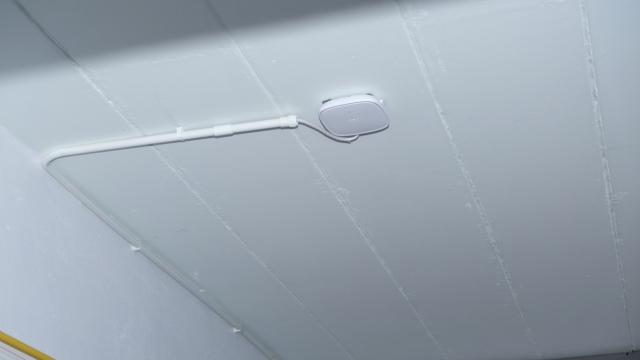The best advice on router placement is advice we all ignore: Place your router in the middle of the room for the best possible wifi. Don’t hide the router away or place it near a wall. This isn’t practical, though, because the walls are where outlets live, and as people have moved to mesh, that means more routers littered throughout the home and more devices to hide. I’ve tried to treat these “wifi pucks” (what I call my Nest routers) as sculpture, worthy of shelf space, but I don’t love it. Once I started adding hubs to each room in the form of Google Minis, things became chaotic, with wires snaking off shelves in each room and these two tiny pieces of tech generally getting in the way.
To solve that problem, I’ve started mounting my hubs and routers to the ceiling, and it works fantastically. Given the amount of accessories that exist to support the idea, I’m clearly not the only one. Ceiling placement solves a lot of problems: It can put the routers in the middle of the room, away from the wall, without the cord issues, and it doesn’t take up counter or shelf space. I hardly notice them there, which makes sense—after all, how often do you notice your smoke detector? It’s such a good idea that some brands, like Eero, that previously required the router by upright, are now designing wall and ceiling-mount routers.
How to mount a wifi router on the ceiling
You’ll need a few items to make this work. First, you’re going to need to find a ceiling mount for your routers or hubs if it doesn’t mount on it’s own, like the Eero, and there are two places to look. Amazon has a surprising number of options for Google brands, and TP Link, and is the best place to look first by just typing “[router name] ceiling mount.” A lot of wall mounts will also work for the ceiling. The surprising place I first found a mount some years back was on Etsy, where a lot of people are 3D printing them, so that’s worth checking out. (Router and hub mounts should be plastic, not metal, so 3D printing makes a lot of sense.) You’ll need a drill, and you’ll want to buy some cord cover, which is usually paintable. Most routers and hubs have six- to eight-foot cords, so you might need to buy a longer cord to reach as far as you need; usually this is just a USB-C cord.
Decide where your equipment is going to go in the room. It doesn’t need to be in the center—the farther away you get from the wall, the better for reception. I recommend attaching your mounts with screws instead of using adhesive: I’ve never found the adhesive to be effective, even on the wall, and you don’t need your router or hub falling to the floor. Orient both your hub and router with the USB input facing the wall. Embed the cords in the cord cover, and then stick it to the ceiling. Lots of cord cover comes with connectors to make turns, but if it doesn’t, just cut the cord cover with an box cutter at a forty five degree angle and put both pieces together to form a corner.
Reception improved at my home, and responsiveness on my Google Minis improved, as well, by simply mounting my devices to the ceiling. It keeps my shelves looking a little neater, and the project cost about fifteen dollars per room. In fact, it’s working so well that if I moved, I’d go to the extra step of installing devices when I install ceiling lights, and hide the cords entirely in the crawlspace.

Leave a Reply
You must be logged in to post a comment.